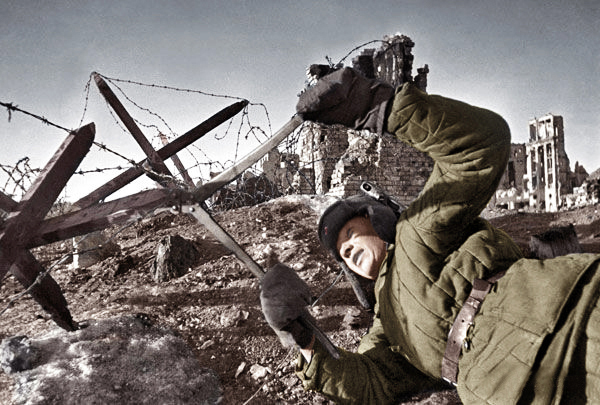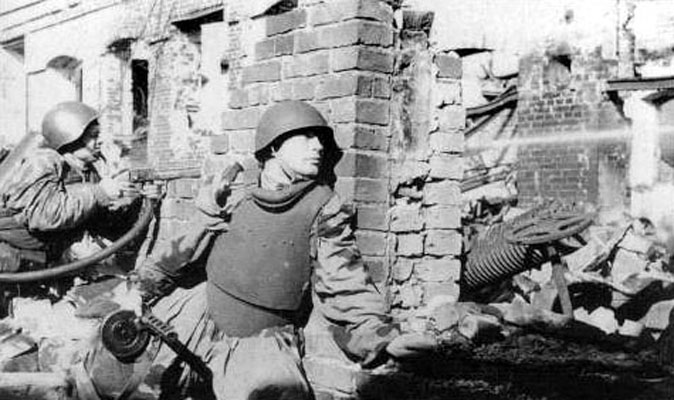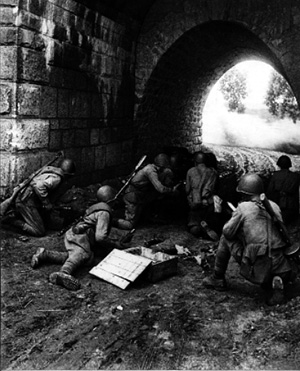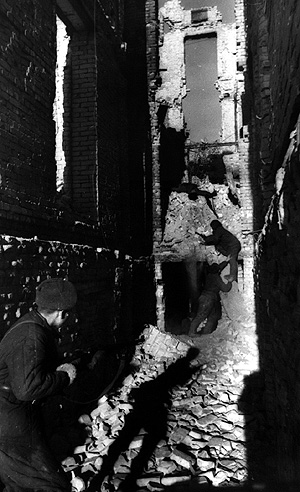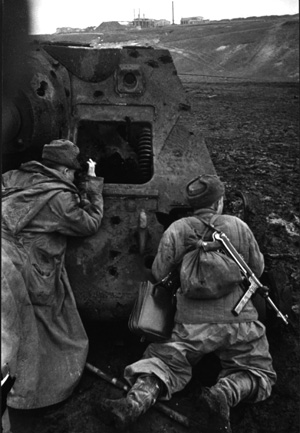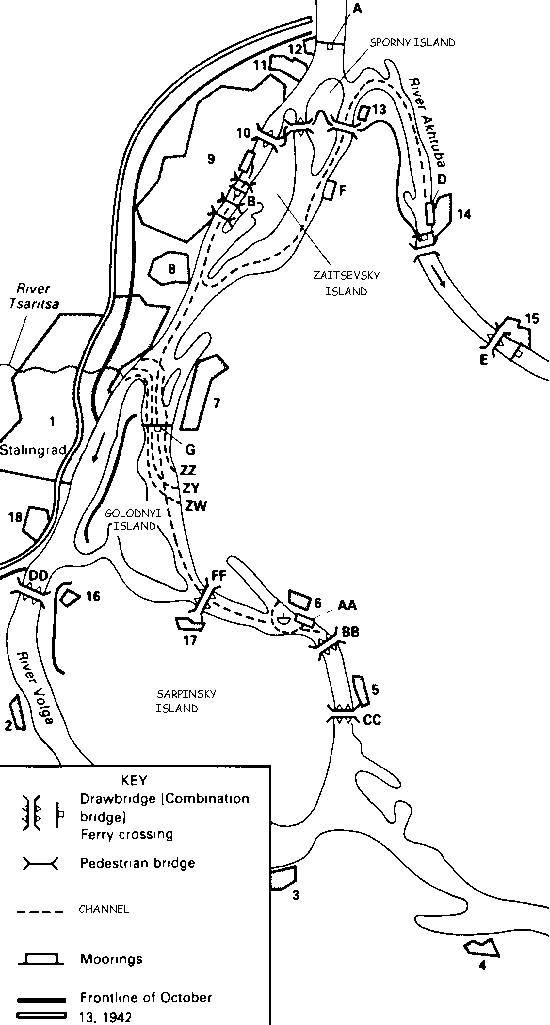|
(One authoritative Soviet source lists somewhat
different figures as 160,000 men; 430 tanks;
600 guns; 14,000 trucks; and 7,000 tons of ammunition.
In any event, the number is
representative of an impressive feat given German
air superiority.)
By practical work done during this period, we learned that even when
there are difficult freezing
conditions the use of standard and small crossing equipment, both towed
and that operated by
oars, is readily possible. The use of pontoons N2P or small metallic
barges towed by motor
launches proved to be very effective under these conditions.
Crossing in rowboats played a great part in supplying the 62nd Army
and the groups cut off
from it. Under the aimed fire of the enemy we crossed reinforcements,
ammunition, and food.
Large numbers of boats were used for the evacuation of the wounded.
For example, on the
night of November 28-29, 360 wounded soldiers were crossed to the left
side in boats.
After we determined the direction of the main blows of our units, we
organized in these areas
observation posts and obeservation points. We arranged a total of 75
points. On an average
on the shock sectors depending upon the importance of the sector and
the character of the
locality, we had from one to three observation posts on each kilometer
of the defense strip
of the enemy. During the period when we carried on reconnaissance in
force, the network
of observation points on these sectors was increased two- or threefold.
The greater part of the observation points were located on the forward
edge of our defenses.
Each of them consisted of a heated blindage-dugout and a rifle pit
with a cover for observation.
Twenty-three observation points were equipped with optical devices,
field glasses, and
telescopes borrowed from the artillery men and the mortar crews. To
each of these
observation points, we assigned a group of three to four engineers
under a junior officer or an
educated private, whose duty it was to direct the group and keep a
record of the observations.
Observation was conducted on a 24-hour basis. The observation data
were plotted on a map
and presented each day to the unit engineer who summarized the data,
put it on a general
map, and in his turn gave the information each day to the higher engineer
chief. On the basis
of the reconnaissance of the defense depths of the enemy from October
l-November 18, we
organized and carried out in the main directions 27 engineer reconnaissance
raids in the rear
of the enemy for the purpose of determining their system, of antilank
and antipersonnel
obstacles and for finding the nature of the rear lines.On the sector
of the 51st Army, this deep
reconnaissance was carried out jointly with the cavalrymen and tankmen.
In the area north of
Stalingrad, we organized seven engineer reconnaissance groups, which
went out under cover
of night to a distance of five kilometers into the depths of the enemy
defenses; camouflaged
themselves there in haystacks, straw, or deep shell holes; and during
the daylime carried on
observation of the engineers and other activities of the enemy. One
group consisting of three
men, under the command of Sergeant Nikolenko, was within the defenses
of the enemy for
three days, moved over a front of 11 kilometers, and made a detailed
field sketching of all
the defense systems on this sector.
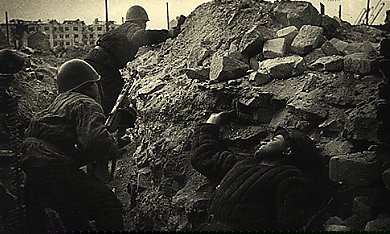
After the breakthrough of the enemy defenses by our troops and the capture
of enemy
defense lines, it was possible to study in more detail on the spot
the system of engineer
obstacles and the placing of the defensive installations and to compare
them with the data of
the engineer reconnaissance. For example, in the zone of the 57th Army,
on the sector
intended for the breakthrough, the engineer scouts of one Guards Division
ascertained
correctly the location of all the minefields of the enemy. With a fair
degree of precision, the
engineers on another sector ascertained the outline of the minefields
over a stretch of 11
kilometers and the defensive installations consisting of barbed-wire
entanglements over a
stretch of 3 kilometers.
In the area of Khalkhuia, engineer reconnaissance of the 28th Army discovered
a total of
37 trenches, 32 fire positions, and 10 mortar positions. In this area,
we discovered a total of
45 defense positions out of a total of 102, which we found later in
the system of enemy
defenses. On this sector, we also discovered the location of three
minefields however,
after the capture of the area, we found four additional fields not
noticed by the scouts.
In the direction of the main blow of the 57th Army, in the area of Tundulovo
and Balka-
Tarnovaia, engineer reconnaissance obtained precise information as
to the location of 35 fire
positions for submachine guns, five earth-and-timber pillboxes, 12
mortar positions, and 28
artillery positions (of these five were concealed). We discovered 70
defense installations out
of a total of 95 that we found to exist after thecapture of the line.
In these directions, at a
depth of up to 3 kilometers, engineer reconnaissance correctly pointed
out the defenses of the
second echelon of the enemy.
Hence, in the main, engineer reconnaissance discovered the system of
German-Rumanian
defenses in the directions of the main attack, thus facilitating to
a considerable extent the
success of the breakthrough of the enemy defenses.
Among the weaknesses in the planning of engineer reconnaissance, we
should mention the
following, the absence of systematic duplication and checking of the
reconnaissance data of
the groups concerning the location of the minefields in the defense
system of the enemy,
and the failure to make use of such methods of reconnaissance as photography,
and in
certain cases, the interrogation of the prisoners.
Covering of the Areas of Concentration
From November 1-15, 1942, the Stalingrad Front carried out a regrouping
and concentration
of troops. The following arrived for reinforcement of the front: 15
rifle divisions, 11 tank
brigades, five motorized rifle and mechanized brigades, and six cavalry
regiments.
For concentrating these forces, we assigned 18 areas. In these areas,
the engineer units of the
front prepared large antitank obstacles. For example, in the zone of
the 64th Army, on the sector
of the Krasnoarmeisk-Beketovka railroad, we provided over a stretch
of 8 kilometers a special
fortification consisting of railway cars fastened together one after
the other to form a powerful
antitank barricade. In combination with minefields and natural obstacles,
this barricade provided
a reliable cover for the zone between the railroad and the Volga.
In the area of Kuporosnoe we constructed five antitank mine centers
and three antitank switch
minefields. In the zone of the 51st Army, in the area of Khargate and
Zurgan, we constructed
five antitank centers and laid eight switch minefields. On the sector
of Malye Derbetyi, Zakhar-
ovo, and Khuslin-Ziur, we constructed three antitank centers and nine
minefields in combination
with barely perceptible obstacles.
In the zone of the front, we prepared minefield coverings for a total
of 19 areas of troop
concentration. We prepared 13 antitank centers and laid 23 minefields.
We laid up to 10,000
mines of various kinds and put out more then 100 packages of barely
perceptible obstacles,
reinforced by landmines and booby traps. These measures enabled us
to carry on concentration
work without being disturbed.
For the passage of the troops from the areas of concentration to the
jump-off lines, the engineer
units of the Front carried out a great deal of work in the making of
passageways through the
engineers' mine obstacles. On the front, in the main directions, we
made a total of 73
passageways having a width of 35 to 400 meters; we removed 12,405 mines
of various kinds and
more than 1,500 bottles with "KS" liquid fuel.
The making of passageways in minefields involved great difficulties.
The work was carried out
exclusively at night, oftentimes under the mortar and machine gun fire
of the enemy. After
rains came freezes. The upper, covering layer of earth was converted
into a solid crust which
froze to the mine covers. Due to the moisture the body of the "lam-5"
swelled and the cotter of
the fuse froze to the side walls of the body of the mine, as a result
of which the modern
simplified fuses oftentimes could not be drawn out. The majority of
mines had to be removed
with the help of grappling-hooks or crowbars. The destruction of the
mines by explosives
was possible only during the time of artillery and mortar fire.
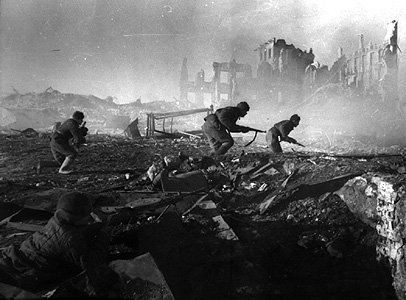
The passage of the troops to the jump-off lines, through the passageways
made, was organized
in the following manner. The commanders of the combat zones and the
unit engineers received
beforehand sketches of the minefield with the passageways indicated
and got acquainted with
them on the spot. For this purpose, we detailed as guides members of
the engineer units who
had a good knowledge of the location of the minefields and the passageways
through them.
From the concentration areas of the units to the minefields, we made
some cross-country routes
of march with signs every 50-100 meters. On these cross-country marches,
we placed traffic
regulation posts. The passageways themselves were marked out accurately
and guarded
by sentries.
The extraordinarily difficult conditions of work in the removal of mines
required miners with
great knowledge, skill, caution, and determination qualities that many
of them lacked because
of their poor training. The unit engineers in particular were poorly
trained. Despite these
weak nesses, however, the engineer units of the front were still able,
before the beginning of
the offensive, to provide the troops the necessary safety measures.
Water Supply for the Troops
The left-flank armies operating in the Kalmuk Steppes encountered serious
difficulties
securing supplies of water.
(It was due to this fact that German forces did
not expect an offensive from this area.)
Some of the units were at a distance of 20 to 25 kilometers from sources
of water.
The water in the "ponds" and lakes was salty or brackish and was unfit
for drinking, preparing
food, or for other purposes. The wells dug by the troops in several
places, even to a depth of 8
meters, gave bitter, salt water. Deepbored wells could not be sunk
because of the lack of the
necessary engineering equipment. Hence, for the units far from a source
of water, it was
necessary to transport water in barrels and drums carried by horses
or camels.
In order to provide a supply of water for the troops, we adopted the
following measures :
an inventory and investigation of all the sources of water in the armies
was made
the army and Front engineer water supply companies began to dig wells
in order to increase
their supply of water
the 28th and 51st Armies, which were in the most unfavorable situation,
were reinforced
with Front specialists for the equipping of the water supply stations
on the routes followed
by the units in order to supply water for the military hospitals, the evacuation
points, and the reserve
regiments in the service area of the Front, we detailed one engineer
water supply company,
which, from November 1-20, repaired nine wells and dug 50 new ones.
The aforementioned
measures, which were carried out by the engineer units of the Front,
made it possible to
supply the troops with water. The difficulty in carrying out this task
was due not so much to
the dryness of the region as it was to the fact that the Front was
poorly supplied with the
means of water supply. The Front and the army engineer water supply
companies did not
have their full strength of personnel and equipment. Experience has
shown that in regard
to the field conditions it is extremely important to have special units
with equipment for
boring deep wells and pumps and filters. It is also necessary to supply
the front with standard
reservoirs.
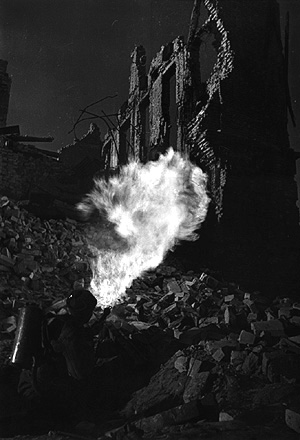 Work of the Engineer Troops in the
Period of the Operation
Supplying Engineer Installations for the Breakthrough
In order to improve engineer preparation for breaking through the defenses
of the enemy, we
selected ahead of time some small engineering units to participate
in the operation and assigned
these to the attacking units. A total of 45 engineer companies were
selected.
From the units selected, we organized 85 groups, each consisting of
10 to 25 men, depending
upon the character of the mission assigned. The basic missions of these
groups were surmounting
the engineer-mine entanglements of the main line of enemy defenses
and accompanying the
attacking units through these entanglements. Each commander heading
a group of engineers,
jointly with the commander of the small unit attacking, studied beforehand
the engineer
reconnaissance data of all their combat sector, planned the route of
movement, and specified
in a concrete manner the missions of the engineer groups as to time
and lines.
Early in the morning of November 20, 1942, several hours before our
troops started their attack
against the main line of enemy resistance, the engineers, under a reinforcing
cover of
submachine guns, light machine guns, and heavy machine guns of the
rifle units, started
clearing the minefields and scattered barbed-wire entanglements of
the enemy. In three and
one-half hours the engineers had made 64 passageways and drawn out
and disarmed more
than 5,000 enemy mines. Where they were not able to construct passageways,
they planned
37 of the most convenient routes for bypassing the minefields.
The minefields of the enemy consisted of metallic German and Rumanian
mines. The basic
and most effective means for discovering them was the mine detector.
However, mine
detectors were used only to a limited extent because of the absence
of BAS-60 batteries.
The operation of searching for the mines and rendering them harmless
was carried out
by probes or grapplers, a method that slowed up the rate of work considerably.
The engineer
-mine entanglements of the enemy were overcome under exceptionally
difficult circumstances
and oftentimes under heavy fire.
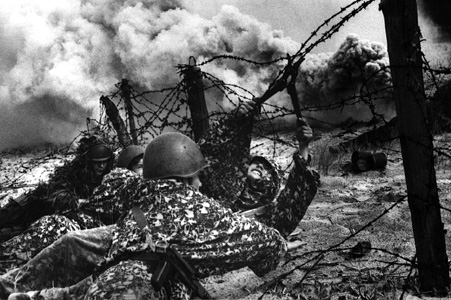 At dawn on November 20, 1942, the troops on the front on the main sectors
assumed the
offensive. There was a thick fog. Before the beginning of the attack,
all the passageways
in the minefield and the detours of minefields were designated by markers
with inscriptions
on them. In the center of each passageway, in narrow trenches having
a depth of 1 to 1,5
meters, there were engineer controllers, provided with signal searchlights,
stakes with flags,
or bunches of straw, by means of which they gave signals upon the approach
of the small
units.
Despite the excellent manner in which this work was planned, precise
coordination between
passage of the combat machines through the minefields and the discipline
of movement over
them was still absent on several sectors. As a result of this, we suffered
unnecessary losses in
equipment.
Accompanying the attacking troops
After the breakthrough of the enemy defenses, the accompanying of the
tanks was entrusted
to the army and front engineer units, the rifle troops and artillery,
however, were accompanied
by regimental and divisional engineers.
(Engineer units were employed to screen the flanks,
and later to cover the front of the 51st
Army during the defensive phase of the Kotelnikovo
operation. Their tasks included
building emplacement and the laying of antitank
minefields.)
The mission of the accompanying forces consisted of providing a passageway
through the
minefields of the enemy. For accompanying the tanks, two or three engineers
mounted a tank,
by external signs, the engineers detected by visual examination the
minefields of the enemy.
When they detected a minefield, they signaled the tank to stop by a
blow with the butt of their
guns upon the armor. They would then demine a passageway, after which
the movement
continued.
In the planning for accompanying the motor-mechanized troops, the failure
to provide the
engineer units with transport proved to be a weakness. After passing
through the minefields
of the enemy, the engineers, in the course of the advance, became separated
from the tanks.
The engineers accompanying the artillery and rifle troops moved with
their units all the time,
carrying out their missions of reconnoitering and removing entanglements,
conducting
reconnaissance of the rear defense lines, and participating in the
blocking of the
earth-and-timber pillboxes of the enemy. It was ascertained that the
enemy had no defensive
installations and entanglements in the rear. We discovered only separate
minefields or groups
of mines on the approaches to inhabited localities and near bridges.
Securing Crossings
Starting on November 18, crossing operations became more complicated,
due to the sudden
worsening of the ice situation and accompanied by a drop in the level
of the water. The rate
of drop of the level of the water on December 20 reached 17.5 centimeters
per day, and by the
end of December it was 26 centimeters. The ice floes in this ten-day
period increased in
diameter up to 40 centimeters and in thickness up to 30 to 40 centimeters.
By the end of the
month, the shoals on the Volga began to affect navigation.
The fall ice floes lasted longer than was predicted. In November and
up to the middle of
December, the hydrometeorological conditions on the Volga in the area
of the front made the
construction of even foot crossings impossible and created great difficulties
in the operation
of ferry crossings. The only foot crossing on the ice was at Astrakhan.
This crossing, which
had a length of 1,600 meters, started operations beginning on the morning
of November 30.
Starting November 18, the drop in the level of the water of the Volga
caused shoals at the
landing places, a condition that was felt acutely toward the end of
the month. In approaching
the landing places, the vessels and barges were disabled temporarily
by running on shoals
and it required a great deal of work to get them off the shoals. The
movement on the Volga
of vessels with a large draft was limited. The abrupt drop in the level
of the water required
at first a lowering of the landing places, and after this due to the
formation of shoals it was
necessary to lengthen them or construct new replacements for those
destroyed by the ice
floes. Thus, at the Kamennyi lar crossing, the ice destroyed 12 landing
places. At this place,
it was necessary to construct four new landing places for loads of
60 tons to replace those
that had been torn up or rendered unfit for use by shoals. The average
length of the trestles
of the landing places was 350 meters.
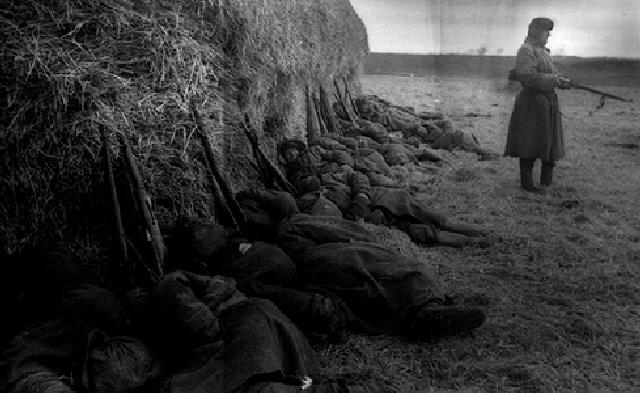 To prevent losses of navigation material and to keep the crossings in
operation, we put into
effect the following measures :
The brigades organized from the workers of the vessel repair plants,
which repaired the
damaged boats at the crossings themselves, made repairs up to and including
the replacement
of rudders and the welding of boilers.
When it was impossible to bring the vessels up to the landing places,
the loading and unloading
was done on the ice itself (the Tatianka crossing had two ice-landing
stages for the loading of
men and freight on N2P pontoons).
For a better utilization of the cutters and the tugs, we increased the
number of pontoons so that
in addition to the pontoons en route there might be pontoons loading
and unloading at the same
time. Such a continuous method of work made it possible for the VMK
cutters at the crossing
of Tatianka lo make 12 lo 19 trips during the daytime.
Under serious ice conditions, the crossing was made on the decks of
self-propelled vessels
without low barges or ferries, and the loading area was increased by
removing a number of
deck superstructures. On November 28, due to the rapid formation of
shoals, the crossing of
wheel and caterpillar loads on barges was temporarily suspended on
all sectors of the Volga,
except at Kammenyi lar. There, the shallowness was not so serious,
and the ice floes were
not as large as a result of theformation of obstructions upstream.
As a result of a number of organizational measures for adapting the
vessels for crossing in the
presence of ice, we soon put the other crossings in operation. For
example, the crossing at
Svetlyi lar continued its work with the paddle-wheel tug "Krasnoflotets"
and other vessels right
up to the freezing of the river. Then the thickness of the ice reached
12 centimeters, and the
temperature of the air went down to minus 16 degrees. Work under such
conditions was
carried out in the following manner: a steam icebreaker of the "Samara"
type went ahead
breaking a channel, and behind it came the powerful tug, "Krasnoflotets,"
followed by all the
other small vessels. In this way, we had a caravan of vessels that
moved in the ice without
any special difficulty. While providing crossing facilities in the
presence of ice floes, we
carried out the preparatory work for the construction of ice roads
for
motor vehicle transport and medium loads. For solving this problem,
the
engineer units at the Front did the following work:
a reconnaissance was made of the points of crossing over the ice in
the areas of Shchuche,
Tatianka, Svetlyi lar, and Krasnyi Oktiabr
in the area of the prospective crossing, more than 10,000 cubic meters
of materials were
collected for reinforcement.
in order to provide for pedestrian traffic and the crossing of loads
at the beginning period of
the freezing, we started the construction of sledrope paths for loads
up to 100 kilograms.
By November 30, we had prepared the sleds, set up and tried out the
drive wire on both
banks, prepared cable, and so on
carried out reconnaissance and selected a place for the construction
of a low-water bridge
across the Volga in the area ofTalianka for loads of 30 tons and prepared
timber for this
purpose in the amount of 6,000 cubic meters.
The number of loads crossed in the initial period of the operation (November
20-December 5,
1942) is shown by the following table :
|
